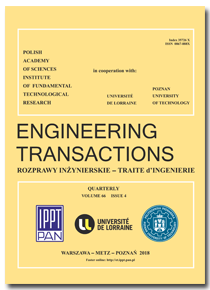10.24423/engtrans.175.2009
Numerical analysis of the effect of torispherical head on the buckling of pressure vessel
References
J. G. Teng and T. Hong, Non-linear thin shell theories for numerical buckling predictions, Journal of Thin-Walled Structures, 31, 89–115, 1998.
X. Wang, J. Xiao and Y. C. Zhang, A method for solving the buckling problem of a thiheln walled sl, International Journal of pressure vessels and piping, 81, 907–912, 2004.
R. Pinna and B. F. Ronald, Hydrostatic buckling of shells with various boundary conditions, Journal of Constructional Steel Research, 56, 1–16, 2000.
J. G. Teng and C. Y. Song, Numerical models for nonlinear analysis of elastic shells with eigenmode-affine imperfections, International Journal of Solids and Structures, 38, 3263–3280, 2001.
J. Blachut, Buckling of sharp knuckle torispheres under external pressure, Thin walled structure, 30, 1–4, 55–77, 1998.
European Convention for Constructional Steelwork ECCS, Technical Working Group 8.4 [Ed.], Buckling of steel shells, European Recommendation, 4th Edition, ECCS, Brussels 1998.
W. Wunderlich and U. Albertin, Buckling behavior of imperfect spherical shells, International Journal of Non-Linear Mechanics, 37, 589–604, 2002.
ANSYS Release 9.0, ANSYS Inc., 2003, Canonsburg, Pensylvania.
Y. Zhao and J. G. Teng, A stability design proposal for cone-cylinder intersections under internal pressure, Int. J. of Pressure and Vessel and Piping, 80, 5, 297–309, 2003.
S. Kenny, N. Pegg and F. Taheri, Dynamic elastic buckling of a slender beam with geometric imperfections subject to an axial impulse. Finite element in analysis and design, 35, 227–246, 2000.
V. P. Veedu and L. A. Carlsson, Finite-element buckling analysis of sandwich columns containing a face/core debond, Composite Structures, 69, 143–148, 2005.
G. J. Turvey and Y. Zhang, A computational and experimental analysis of the buckling, post-buckling and initial failure of pultruded GRP columns, Journal of Computers and Structures, 84, 1527–1537, 2006.
J. G. Teng, Elastic buckling of cone-cylinder intersection under localized circumferential buckling, Journal of Engineering Structure, 18, 41, 1996.
J. G. Teng and M. Hong–Wei, Elastic buckling of ring-stiffened cone-cylinder intersections under internal pressure, ASME International Journal of Mechanical Science, 41, 357–383, 1999.
C. D. Miller, Buckling criteria for torispherical heads under internal pressure, International Journal of Pressure Vessel Technology, 123, 318–323, Aug. 2001.
R. T. Shield and D. C. Drucker, Design of thin-walled torispherical and toriconical pressure vessel heads, ASME Int. Journal of Applied Mechanics, 28, 292–297, 1961.
DOI: 10.24423/engtrans.175.2009




